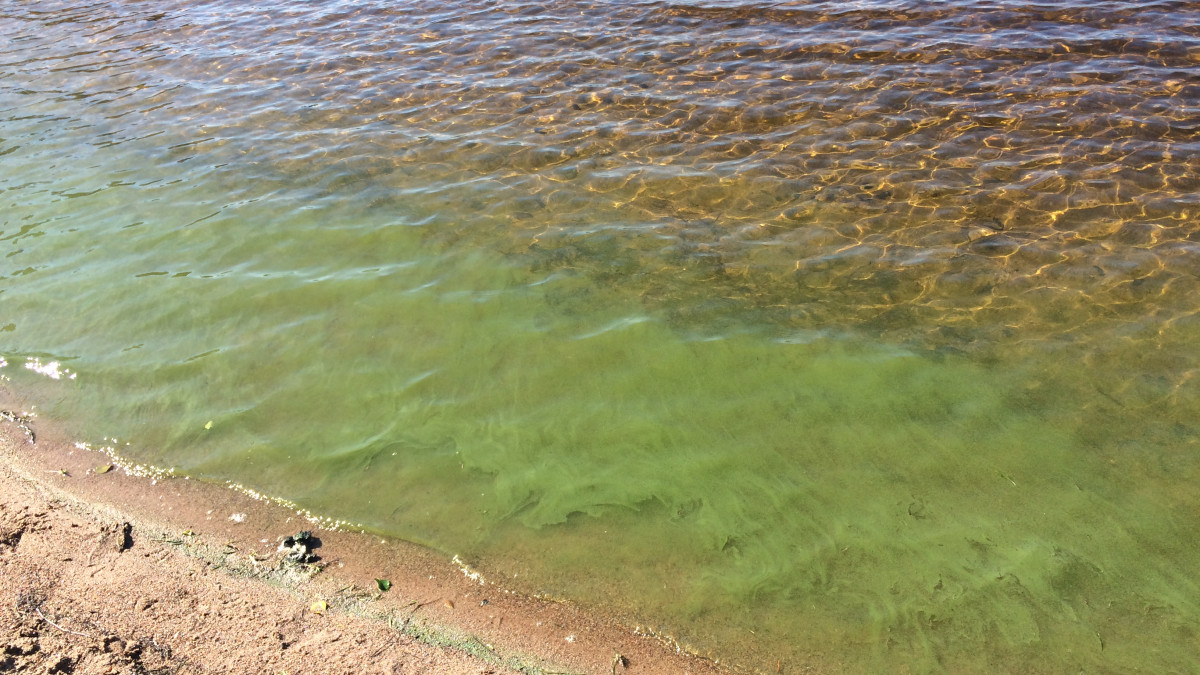
- Environmental protection
- Health surveillance
- Animals
- Decision
- Online transaction
- Contact us

Blue-green algae are a natural part of aquatic life, but when they become abundant they can cause problems, as some species are poisonous. About half of the mass occurrences of blue-green algae have been found to be toxic. The toxicity of the species varies and the toxicity can only be determined with certainty in laboratory tests. Some blue-green algae produce neurotoxins and liver toxins.
Blue-green algae are microscopically small, single-celled algae that form colonies of various shapes. Depending on the species, the community can appear in the water as small flakes (genera Anabaena and Microcystis in inland waters, Nodularia in brackish waters) or as sharp sticks (Aphanizomenon in both inland and brackish waters). When it becomes abundant, it forms bands and algal rafts and colors the water, sometimes making it look like latex paint. The pulp is a loose porridge that can be brown or green in color, as it ages and dries, the pulp can be turquoise or almost white. Blue-green algae mass smells earthy and musty.
A visible mass of blue-green algae is called a bloom, even though it doesn't actually form any flowers. It is difficult to predict and control the occurrence and duration of blooms, i.e. blue-green algae blooms. Winds and currents can move the blue-green algae mass, so the amount of blue-green algae in the water can change quickly even during the same day. Blue-green algae deposits start to appear when the waters warm up, usually around Midsummer, and they may continue well into autumn. The abundance and extent of occurrences varies annually depending on weather conditions and nutrients.
Blue-green algae can be identified with a glass or stick test. During the drinking glass test, the water stands in the glass for about an hour, during which the blue-green algae rises to the surface. However, blue-green algae does not always rise to the surface, but is visible in the water as green bits. The water should therefore be examined carefully before possible use. The small green particles on the surface are blue-green algae. In the stick test, you try to lift the algae mass into the air with a stick. If the algal mass breaks down into small green particles in the water, the alga is blue-green algae.
Recording observations in Järviwiki
Algae observations can be easily recorded in the Environmental Administration's Järviwiki through the Havintolähetti service, the browser version of which also works on a phone. Observations can also be reported to local environmental authorities, from which the information is forwarded to the national algae monitoring. On the Järviwiki website, you can also familiarize yourself with the blue-green algae observations made by others.
Observation transmitter: https://www.jarviwiki.fi/havaintolahetti/
It is worth noting that the sites only show the observations reported or made there. The blue-green algae situation may change quickly. You should always keep your eyes open and make your own observations and act according to the situation.
The observation of blue-green algae in water areas is based on residents' observations and reports, as well as observations made in connection with sampling and monitoring. There is no regular monitoring of blue-green algae, apart from the monitoring of swimming beaches and national observation sites.
The municipal health protection authority that supervises public swimming beaches does not visit the beach every day to assess the occurrence of blue-green algae and does not report on the blue-green algae situation every day. Therefore, the swimmer should visually assess the state of the swimming water before swimming.
If you notice blue-green algae in the swimming water, you should notify the health protection authority. The health protection authority's information can be found on the notice board of the swimming beach and on the municipality's website.
Some blue-green algae can produce liver or nerve toxins. In addition to toxins, blue-green algae can produce compounds that irritate the skin, among other things. Based on the appearance of the blue-green algae deposit, it is not possible to judge whether it is a toxin-producing blue-green algae species or not.
People's sensitivity to symptoms caused by blue-green algae varies. Symptoms usually appear within a few hours of exposure to blue-green algae.
Blue-green algae can cause
If you have symptoms or suspect that you swam in blue-green water, wash thoroughly with plenty of clean water and soap. Usually the symptoms go away without treatment, and if necessary, you can take fever and pain medicine. If the symptom is also abundant vomiting and diarrhea, there is a risk of dehydration. In that case, you should seek treatment by calling Eksoten's emergency help number 116 117. Similarly, symptoms of swelling of the skin that require treatment combined with abundant redness or difficult respiratory symptoms are reasons to seek emergency care. You can also ask for advice from the HUS Poison Information Center on 0800 147 111.
It is impossible to estimate the duration of the presence of blue-green algae. If the water has or you know been in it recently blue-green algae, remember these things:
For more information:
Environmental action of the Imatra region, health control imatra.fi (health control[at]imatra[dot]fi)
imatra.fi (health control[at]imatra[dot]fi)
environmental engineer Marcella Suomalainen, tel. 020 617 4324, marcella. Finnish imatra.fi (marcella[dot]suomalainen[at]imatra[dot]fi)
imatra.fi (marcella[dot]suomalainen[at]imatra[dot]fi)
environmental engineer Sirpa Heinänen, tel. 020 617 4391, sirpa.heinanen imatra.fi (sirpa[dot]heinanen[at]imatra[dot]fi)
imatra.fi (sirpa[dot]heinanen[at]imatra[dot]fi)
Terveyden en hyvinvoinnin laitos
Finnish Environmental Center
This is how you identify blue-green algae (Lake Wiki)